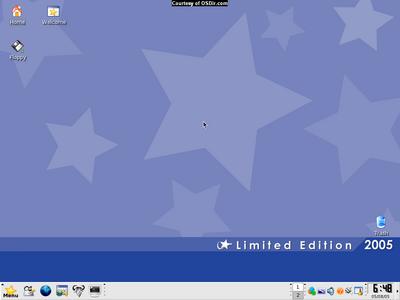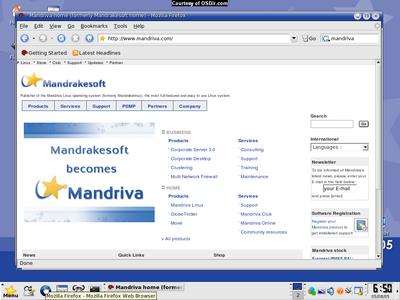Mandriva Linux (formerly Mandrakelinux or Mandrake Linux, and a merger with Conectiva) is a GNU/Linux distribution created by Mandriva (formerly Mandrakesoft). The first release was based on Red Hat Linux (version 5.1) and KDE (version 1.0) in July 1998. It has since diverged from Red Hat and has included a number of original tools mostly to ease system configuration. Mandriva Linux is also notable for compiling its packages with optimizations for Pentium-class and more advanced processors which are incompatible with older CPU versions such as 386 and 486. Mandriva Linux (at those times named Mandrake Linux) was originated by Gaël Duval, who was also a co-founder of Mandrakesoft.
 Mandriva logo
Mandriva logoMandrakelinux 10.1 Community desktop (w/KDE)
Features
The major features of Mandriva Linux are:
Internationalization
Mandriva Linux supports over 74 languages
Installation, control and administration
Mandriva Linux uses the Mandrake Control Center for administration of Linux rather than using a text editor to change settings. It has many programs known as Drakes or Draks, collectively named drakxtools, to configure many different settings. Examples include MouseDrake to set up a mouse, DiskDrake to set up disk partitions and drakconnect (previously known as draknet but forced to change its name after a company of the same name complained) to set up a network connection. They are written using GTK and Perl, and most of them can run in both graphical and text mode.
Software
Mandriva Linux comes with several thousand software packages including many varieties of games, office software, servers, and Internet utilities.
Community
Mandriva Linux has a large community of users, that provide help, support, and software to the user of Mandriva Linux.
Constant development
Mandriva Linux is constantly in development. A development version of Mandriva Linux, known as the "Cooker" is publicly available, but it is not recommended for use in a production environment because of the constant changes going on in it.
Next to that, community members provide RPMs for the latest packages of popular software.
Optimization
From the ground up, Mandriva Linux was compiled for Pentium-class processors. As a result, Mandriva Linux provides more optimal performance to this CPU Architecture at the cost of being unusable by the 386 and 486 processors, a problem that rapidly faded out due to current CPU power and memory requirements of latest versions of the popular software.
The provided kernel and glibc have enhancements for more recent processors. For example, the glibc will load libraries from the special directory /lib/i686 if the detected processor is compatible.
Desktops
 Mandriva Linux is geared to use KDE or GNOME as the standard desktops, but includes others such as IceWM, Blackbox, Window Maker and Twm. A unique theme known as "Mandrakegalaxy" provides consistency between applications and desktop environments. Mandrakegalaxy debuted in version 9.1 and Mandrakegalaxy II appeared in 10.0. A variant of Mandrakegalaxy is "Mandrakegalaxy Squared", which uses square window buttons rather than round ones.
Mandriva Linux is geared to use KDE or GNOME as the standard desktops, but includes others such as IceWM, Blackbox, Window Maker and Twm. A unique theme known as "Mandrakegalaxy" provides consistency between applications and desktop environments. Mandrakegalaxy debuted in version 9.1 and Mandrakegalaxy II appeared in 10.0. A variant of Mandrakegalaxy is "Mandrakegalaxy Squared", which uses square window buttons rather than round ones.Package manager
Mandriva Linux uses a package manager called urpmi, which functions as a wrapper to the RPM package management system. It is similar to apt-get in that it allows seamless installation of a given software package by automatically installing the other packages needed. It is also media-transperent due to its ability to retreive packages from various media, including network/internet, CD/DVD and local disk. Urpmi also has an easy-to-use graphical front-end called RPMdrake which is integrated into the Mandrake Control Centre.
Although web sources for urpmi are not added on the installation of Mandriva Linux, they are available at EasyUrpmi (http://easyurpmi.zarb.org/) or through an option in the Software Sources Manager in versions above 2005LE (10.2). This functionality allows the user to choose some or all of the various software repositories available for their version of Mandrivalinux and can greatly expand the amount of software that the user can install through the urpmi system.
Name changes
From its inception to version 8.0, Mandrake named its flagship distribution Linux-Mandrake. From version 8.1 to 9.2 it was called Mandrake Linux.
In February 2004 MandrakeSoft lost a court case against Hearst Corporation, owners of King Features Syndicate. Hearst contends that MandrakeSoft is infringing upon King Features' trademarked character Mandrake the Magician. The word Mandrake is not unique to the King Features character, and MandrakeSoft is appealing the decision. As a precaution, MandrakeSoft has renamed its products by removing the space between the brand name and the product name and changing the first letter of the product name to lower case, thus creating one word. Starting from version 10.0, Mandrake Linux became known as Mandrakelinux, and its logo changed accordingly. Similarly, MandrakeMove became Mandrakemove.
In April 2005 Mandrakesoft annouced that after the corporate merger (http://www.mandriva.com/company/press/pr?n=/pr/corporate/2539) of Mandrakesoft and Conectiva, and the legal dispute with Hearst Corporation, the new company name would be Mandriva, and that Mandriva Linux would be the new name covering products.
Versions
Variants of the same version
Prior to Mandrakelinux 10.0, there was one central distribution which was marketed to consumers and made available for download over the Internet (besides the offspring, detailed below). The development tree of Mandrakelinux has always been known as Cooker. When stabilised, this tree becomes the successor to the current version.
Latest version
The latest version, Limited Edition 2005 was released to Mandriva Club members and on Mandriva Store 13 April, 2005. Free downloads of ISO CD images for the PowerPC platform were released on 29 April, 2005, followed by i586 (Intel) and x86_64 (AMD64) images on 3 May, 2005. This is in line with Mandriva's new strategy of making releases available first to paying customers.
The largest changes from 10.1 includes: use of KDE 3.3 instead of 3.2 and GNOME 2.8 instead of 2.6, replacing Mozilla by Mozilla Firefox, transition to GIMP 2.2 and GCC 3.4, and changes in the Mandriva Control Center.
The Free Edition contains some advertisements in the form of bookmarks in the web browser and slides during installation, as well as is available for download later, to help cover the costs of producing the distribution.